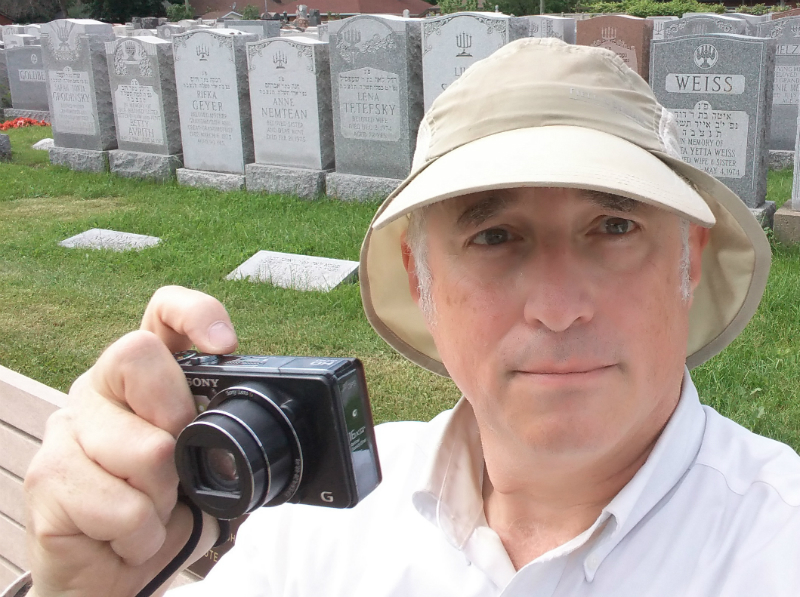Gary Perlman calls himself a retired software developer, which hardly does credit to the 30 years he spent in the United States riding the wave of information technology from its earliest ripple.
The Montreal native, who holds a PhD from the University of California at San Diego, today prefers to be known as a “volunteer amateur genealogist,” but that, too, is modest.
The Jewish Genealogical Society of Montreal (JGS) certainly thinks so. It has nominated Perlman, its webmaster, for the volunteer of the year award, which will be bestowed at the International Association of Jewish Genealogical Societies (IAJGS) conference that’s being held in Cleveland from July 28 to Aug. 2.
Over the past four years, Perlman has photographed more than 30,000 gravestones in Jewish cemeteries in the Montreal area, and updated the records of thousands. And he’s nowhere near finished.
In total, he has made 39,271 submissions to the JewishGen Online Worldwide Burial Registry (JOWBR), a database of more than three million names and other pieces of information from cemeteries and burial records archives around the world.
The updates include 1,396 corrections to family names and 2,350 corrections to given names, he said.
Burial sites and documentation provide a wealth of information to those who are researching their family histories. But it has to be accurate, and the online images of gravestones must be legible. Discrepancies between what the stone reveals and what was in written records can send a researcher completely off track.
READ: AMATEUR GENEALOGISTS ARE UNRAVELLING THEIR FAMILY HISTORIES MORE EASILY THAN EVER BEFORE
Perlman’s most complete project – and most challenging – is the Back River Cemetery in Montreal’s Ahuntsic-Cartierville borough, which dates back to the late 19th century and was in poor condition for many years. He has now shot virtually all of its close to 7,000 gravestones.
Many were worn or damaged. Yet through countless hours of trial and error, Perlman found ways of bringing out the faded inscriptions. Often, he had only a short window of opportunity when the light hit the stone in a way that compensated for the deterioration.
Another task was translating Hebrew-only wording, and Perlman has found other volunteers to help in this task.
“It’s really tedious – and often dirty,” Perlman said.
JOWBR co-ordinator Nolan Altman, in endorsing Perlman’s nomination for the IAJGS volunteer of the year award, praised his “clear, complete and precise” submissions.
“In addition to updating existing entries from the cemeteries in the area, he has been photographing headstones from cemeteries where JewishGen only had the record information,” wrote Altman. “With the addition of the photos, the crucial Hebrew patronymic names will now be available to help researchers link generations together.
“Not satisfied with some of the existing photographs in our database, Gary has re-photographed specific headstones and spent the time and effort to make the inscription as readable as possible.”
Perlman has come across some unusual final resting places. “One grave had a racquetball racquet, and another had a footstone with an image of a ‘lifelong lover of fly fishing,’ ” he said.
“A personal favourite of mine is a gravestone with the date Feb. 29, 1898, but 1898 was not a leap year. Then there are gravestones that face away from the grave; for many, there’s a good reason, but for some, I’ve been told it’s probably due to an unpaid bill.”
Perlman also created the Genealogy Dashboard, which allows visitors to the JGS website to enter a name and be presented with about 100 genealogical resources on one screen.
Lending his technological expertise to other amateur genealogists is a natural extension of what Perlman did professionally. He spent most of his career developing more accessible information systems. For 17 years, he worked for the Online Computer Library Center, a nonprofit co-operative that provides shared technology services.
As if the cemetery sleuthing has not kept him busy enough, for the past five years, Perlman has volunteered at the Maimonides Geriatric Centre. Working with the therapeutic recreation department, he offers residents the chance to delve into their ancestry and, to date, has produced 22 extensive family trees for them.
“Gary has spent countless hours interviewing and speaking with residents and their families and doing research with the goal of gleaning information wherever he can, to provide accurate life stories.… Most importantly, Gary gave our residents the opportunity to talk about their past. Often, these visits were the highlight of the residents’ week,” said Patti Derstenfeld, Maimonides’ co-ordinator of volunteer services, adding her support to Perlman’s nomination.
“My clients sometimes get verklempt when I find a record, such as a marriage record, with birth names of all four parents, or a signature not seen for decades,” said Perlman, who typically spends 10 to 20 hours a week digging. “It can be incredibly time consuming, but it’s fun and rewarding, and appreciated.”
Perlman, who returned to Montreal in 2003, credits his late-blooming interest in genealogy to the JGS and its president, Stanley Diamond. He attended one of the JGS’s regular Sunday Morning Family Tree Workshops, where beginners can get one-on-one help, and was hooked.
Perlman’s great-grandparents immigrated to Montreal between 1900 and 1913 from Romania, Belarus and Bukovina.
Diamond, who is also a founder and executive director of Jewish Records Indexing-Poland, can’t praise Perlman’s work enough. “I have treasured those volunteers who not only step forward when asked, but who carry out their tasks with passion and devotion in the most professional manner,” he said. “Among all I have had the sincere pleasure to have worked with, Gary is most certainly one of the best in this regard.”
